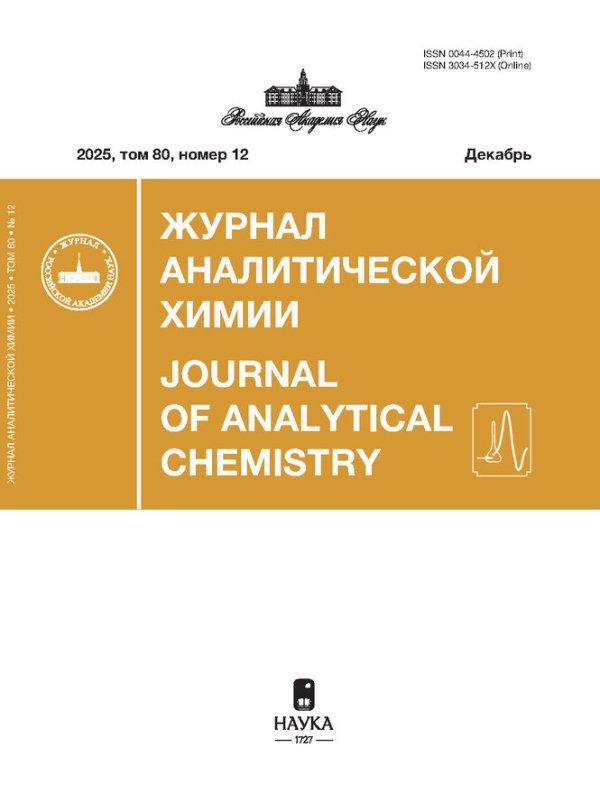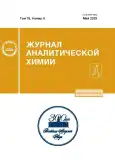Сравнение метода “пик/фон” и эмпирической корректировки результатов при электронно-зондовом энергодисперсионном количественном анализе порошковых материалов
- Авторы: Пухов Д.Э.1
-
Учреждения:
- Ярославский филиал Физико-технологического института им. К.А. Валиева Российской академии наук
- Выпуск: Том 78, № 5 (2023)
- Страницы: 469-480
- Раздел: ОРИГИНАЛЬНЫЕ СТАТЬИ
- Статья получена: 14.10.2023
- URL: https://bakhtiniada.ru/0044-4502/article/view/136044
- DOI: https://doi.org/10.31857/S0044450223050110
- EDN: https://elibrary.ru/MIRCWN
- ID: 136044
Цитировать
Полный текст
Аннотация
Рассмотрены в сравнении несколько алгоритмов корректировки результатов электронно-зондового количественного элементного анализа образцов с неровной поверхностью и порошковых материалов. Эффективность методов оценивали по отклонениям скорректированных массовых долей элементов от результатов, получаемых на образцах сравнения, в качестве которых применяли полированные пластинки анализируемого материала. При использовании наиболее часто употребляемого метода “пик/фон” интенсивность непрерывного рентгеновского излучения рассчитывали несколькими способами. Первый способ предполагает аналитический расчет функции генерации тормозного излучения и коррекцию ширины и формы спектра тормозного излучения под диагностическими линиями элементов на основе экспериментальных спектров. Второй, более экспрессный способ базируется на непосредственном моделировании непрерывного фона излучения методами Монте-Карло в программной среде NIST DTSA-II. Второй способ расчета фона непрерывного излучения позволяет добиться меньших отклонений результатов количественного анализа от результатов, полученных на образцах сравнения. Также протестирован эмпирический метод корректировки. Он основан на экспериментально выявленных закономерностях в энергодисперсионных спектрах порошковых образцов. При анализе экспериментальных данных установлена зависимость, связывающая параметры характеристических фотонов с величиной ускоряющего напряжения, необходимого для получения корректного соотношения массовых концентраций элементов при анализе порошкообразных материалов. Предлагаемый эмпирический метод корректировки результатов анализа порошковых образцов по совокупности проведенных анализов является более эффективным.
Ключевые слова
Об авторах
Д. Э. Пухов
Ярославский филиал Физико-технологического института им. К.А. Валиева Российской академии наук
Автор, ответственный за переписку.
Email: puhov2005@yandex.ru
Россия, 150007, Ярославль, ул. Университетская, 21
Список литературы
- Armstrong J.T., Buseck P.R. Quantitative chemical analysis of individual microparticles using the electron microprobe: Theoretical // Anal. Chem. 1975. V. 47. № 13. P. 2178. https://doi.org/10.1021/ac60363a033
- Goldstein J.I., Newbury D.E., Michael J.R., Ritchie N.W.M., Scott J.H.J., Joy D.C. Scanning electron microscopy and X-ray microanalysis. 4rd Ed. New York: Springer, 2018. 550 p. https://doi.org/10.1007/978-1-4939-6676-9
- Newbury D.E. Electron probe microanalysis of rough targets: Testing the peak-to-local background method // Scanning. 2004. V. 26. № 3. P. 103. https://doi.org/10.1002/sca.4950260302
- Small J.A. The analysis of particles at low accelerating voltages (≤10 kV) with energy dispersive X-ray spectroscopy (EDS) // J. Res. Natl. Inst. Stan. 2002. V. 107. № 6. P. 555. https://doi.org/10.6028/jres.107.047
- Buseck P.R. A general characteristic fluorescence correction for the quantitative electron microbeam analysis of thick specimens, thin films and particles // X-Ray Spectrom. 1985. V. 14. № 4. P. 172. https://doi.org/10.1002/xrs.1300140408
- Newbury D.E., Ritchie N.W.M. Quantitative SEM/EDS, step 1: What constitutes a sufficiently flat specimen? // Microsc. Microanal. 2013. V. 19. № 2. P. 1244. https://doi.org/10.1017/s1431927613008210
- Bayazid S.M., Yuan Y., Gauvin R. Study of the peak to background (P/B) method behavior as a function of take-off angle, tilt angle, particle sze, and beam energy // Scanning. 2021. V. 7. Article ID 8070721. https://doi.org/10.1155/2021/8070721
- Hovington P., Lagace M., Rodrigue L. X-ray analysis of rough surfaces at low energy // Microsc. Microanal. 2002. V. 8. № 2. P. 1472. https://doi.org/10.1017.S1431927602103990
- Newbury D.E., Ritchie N.W.M. Performing elemental microanalysis with high accuracy and high precision by scanning electron microscopy/silicon drift detector energy-dispersive X-ray spectrometry (SEM/SDD-EDS) // J. Mater. Sci. 2015. V. 50. № 2. P. 493. https://doi.org/10.1007/s10853-014-8685-2
- Armstrong J.T. Quantitative elemental analysis of individual microparticles with electron beam instruments / Electron Probe Quantification / Eds. Heinrich K.J.F., Newbury D.E. N.Y.: Plenum Press, 1991. P. 261. https://doi.org/10.1007/978-1-4899-2617-315
- Gauvin R., Hovington P., Drouin D. Quantification of spherical inclusions in the scanning electron microscope using Monte Carlo simulations // Scanning. 1995. V. 17. № 4. P. 202. https://doi.org/10.1002/sca.4950170401
- Storms H.M., Janssens K.H., Torok S.B., Van Grieken R.E. Evaluation of the Armstrong-Buseck correction for automated electron probe X-ray microanalysis of particles // X-Ray Spectrom. 1989. V. 18. P. 45. https://doi.org/10.1002/xrs.13001820
- Sanchez D., Llovet X., Graciani R., Salvat F. A tracking algorithm for Monte Carlo simulation of surface roughness in EPMA measurements / IOP Conf. Ser.: Mater. Sci. Eng., 2018. V. 304. P. 1. https://doi.org/10.1088/1757-899x/304/1/012015
- Paoletti A., Bruni B.M., Gianfagna A., Mazziotti–Tagliani S., Pacella A. Quantitative energy dispersive X-ray analysis of submicrometric particles using a scanning electron microscope // Microsc. Microanal. 2011. V. 12. № 5. P. 710. https://doi.org/10.1017/s1431927611000432
- Ritchie N.W.M. Using DTSA-II to simulate and interpret energy dispersive spectra from particles // Microsc. Microanal. 2010. V. 16. № 3. P. 248. https://doi.org/10.1017/s1431927610000243
- Trincavelli J.C., Van Grieken R.E. Peak-to-background method for standardless electron microprobe analysis of particles // X-Ray Spectrom. 1994. V. 23. P. 254. https://doi.org/10.1002/xrs.1300230605
- Labar J.L., Torok S.B. A Peak-to-background method for electron-probe X-ray microanalysis applied to individual small particles // X-Ray Spectrom. 1992. V. 21. P. 183. https://doi.org/10.1002/xrs.1300210407
- Castellano G., Osanb J., Trincavelli J.C. Analytical model for the bremsstrahlung spectrum in the 0.25–20 keV photon energy range // Spectrochim. Acta B. 2004. V. 59. P. 313. https://doi.org/10.1016/j.sab.2003.11.008
- Limandri S.P., Bonetto R.D., Josa V.G, Carreras A.C., Trincavelli J.C. Standardless quantification by parameter optimization in electron probe microanalysis // Spectrochim. Acta B. 2012. V. 77. P. 44. https://doi.org/10.1016/ j.sab.2012.08.003
- Ding Z.-J., Shimizu R., Obori K. Monte Carlo simulation of x-ray spectra in electron probe microanalysis: Comparison of continuum with experiment // J. Appl. Phys. 1994. V. 76. № 11. P. 7180. https://doi.org/10.1063/1.357998
- Eggert F. The P/B-method, about 50 years a hidden champion // Microsc. Microanal. 2018. V. 24. № 1. P. 734. https://doi.org/10.1017/s1431927618004166
- Small J.A., Leigh S.D., Newbury D.E., Myklebust R.L. Modeling of the bremsstrahlung radiation produced in pure-element targets by 10–40 keV electrons // J. Appl. Phys. 1987. V. 61. № 2. P. 459. https://doi.org/10.1063/1.338245
- Duncumb P., Barkshire I.R., Statham P.J. Improved X-ray spectrum simulation for electron microprobe analysis // Microsc. Microanal. 2001. V. 7. № 4. P. 341. https://doi.org/10.1007/s10005-001-0010-6
- Riveros J.A., Castellano G., Trincavelli J.C. Comparison of φ(ρz) curve models in EPMA // Mikrochim. Acta. 1992. V. 12. P. 99. https://doi.org/10.1007/978-3-7091-6679-6-7
- Drouin D., Couture A.R., Joly D., Tastet X., Aimez V., Gauvin R. CASINO V2.42 – A fast and easy-to-use modeling tool for scanning electron microscopy and microanalysis users // Scanning. 2007. V. 29. № 3. P. 92. https://doi.org/10.1002/sca.20000
- Drouin D., Hovington P., Gauvin R. CASINO: A new Monte Carlo code in C language for electron beam interaction – Part II: Tabulated values of Mott cross section // Scanning. 1997. V. 19. № 1. P. 20. https://doi.org/10.1002/sca.4950190103
- Hovington P., Drouin D., Gauvin R. CASINO: A new Monte Carlo code in C language for electron beam interaction – Part I: Description of the program // Scanning. 1997. V. 19. № 1. P. 1. https://doi.org/10.1002/sca.4950190101
- Hovington P., Drouin D., Gauvin R., Joy D.C., Evans N. CASINO: A new Monte Carlo code in C language for electron beam interaction – Part III: Stopping power at low energies // Scanning. 1997. V. 19. № 1. P. 29. https://doi.org/10.1002/sca.4950190104
- Ritchie N.W.M. Spectrum simulation in DTSA-II // Microsc. Microanal. 2009. V. 15. № 5. P. 454. https://doi.org/10.1007/s10853-014-8685-2
- Newburry D.E., Ritchie N.W.M. Measurement of trace constituents by electron-excited X-ray microanalysis with Energy-dispersive spectrometry // Microsc. Microanal. 2016. V. 22. № 3. P. 520. https://doi.org/10.1017/s1431927616000738
- Newburry D.E., Ritchie N.W.M. Quantitative electron-excited X-ray microanalysis of borides, carbides, nitrides, oxides, and fluorides with scanning electron microscopy/silicon drift detectore-dispersive spectrometry (SEM/SDD-EDS) and NIST DTSA-II // Microsc. Microanal. 2015. V. 21. № 5. P. 1327. https://doi.org/10.1017/s1431927615014993
- Пухов Д.Э., Лаптева А.А. Способ корректировки результатов электронно-зондового энергодисперсионного элементного анализа порошковых материалов // Журн. аналит. химии. 2022. Т. 77. № 9. С. 837. (Pukhov D.E., Lapteva A.A. Method for correcting the results of energy-dispersive electron probe elemental analysis of powder materials // J. Anal. Chem. 2022. V. 77. № 9. P. 1162. https://doi.org/10.1134/s106193482209011810.1134/s1061934822090118)https://doi.org/10.31857/s0044450222090110
Дополнительные файлы

















